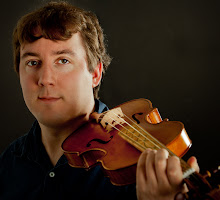I thought differently, of course, and in an effort to persuade him, I suggested that I would bring in a recording I had of Rachel Podger playing Bach's unaccompanied Sonatas and Partitas, a fantastic rendition which I would still place in the top tier of any other recording (both modern and baroque) that I've ever heard. He agreed that he would listen to it and tell me what he thought.
The day after I brought it in for him to take home and listen to, he came up to me holding out the CD for me to take back. "I listened to the first few bars of the G minor sonata," he said, "and had to turn it off." I was blown away! "What?" I remember saying, "you didn't like it?" His response was "It was a semitone too low; I couldn't listen to it."
The day after I brought it in for him to take home and listen to, he came up to me holding out the CD for me to take back. "I listened to the first few bars of the G minor sonata," he said, "and had to turn it off." I was blown away! "What?" I remember saying, "you didn't like it?" His response was "It was a semitone too low; I couldn't listen to it."
The standardised modern pitch of A440 was so ingrained in him that he wasn't able to listen to more than a few bars of such familiar music played at A415. I wonder what his reaction would have been if I'd lent him Elizabeth Wallfisch's recording, performed at the even lower pitch of around A392.
His reaction was an extreme one, and I think many people nowadays are perfectly fine listening to different music tuned at different pitches. However, this issue of familiarity is a significant one that stretches well beyond the question of at what frequency the pitch A is set. Many of us are so familiar with the vibrant, flexible sound of gut strings that we just can't bear the constant, dull sound of steel. (Or, from the opposite perspective: many of us are so familiar with the smooth, passionate, luxurious sound of steel strings that we just can't stand the scratchy and unreliable gut.) We may be so familiar with the powerful sound of a Steinway piano that we can't enjoy the fortepiano or harpsichord. We're so familiar with the notion that constant vibrato is fundamental to a good sound that we can't tolerate a seemingly inexpressive non-vibrated string sound. We're so accustomed to equal temperament that anything else just sounds hideously out of tune. Most dangerously, we may be so familiar with how it's done on a particular recording that we are unable to open our ears to different approaches during rehearsals.
Like an eye adjusting gradually to an abrupt change of light, the ear too can, and I believe must, adapt to new sounds and timbres. It just takes time and exposure. I only wish that my violinist colleague had listened to more than just a few bars of the Rachel Podger recording, then he may have started hearing the music making, rather than just the pitch centre.
But I can understand the instant aversion, that feeling of "this is wrong!" Having performed for the last couple of years mainly at A415, whenever I hear a modern orchestra tuning up I always think "Why on earth are they tuning to B flat?"

Mr Andrewes,
ReplyDeleteI think your text hints on this, but the corollaries to contemporary NEW music are staggering. Early music and New music are absolute bed-fellows in the contemptuous aural world we live in. Wonderful communication of thoughts here, I would love to see you expand to mention these crossovers.
Cheers!
MARK OLIVEIRO
Thanks Mark, I hadn't really though of that, but I think you're spot on, and I will definitely write a future post about it!
ReplyDelete